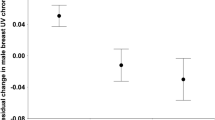Summary
The Barn Owl (Tyto alba) varies in plumage from dark reddish-brown to white, and from heavily marked with black spots to immaculate. Males are commonly lighter coloured and less spotted than females. I assessed whether male and female Barn Owls delay the full expression of plumage coloration and spottedness to the second year of life. In Switzerland, I quantified the two traits of birds captured at the nestling stage, first, second and third year of life. Males and females became lighter coloured only from the first to the second year. Males became less spotted only from the first to the second year, and females less spotted from the nestling stage to the first year but more spotted from the first to the second year. Females were also similarly spotted at the second and third year of age. By cutting off small pieces of feathers of females I could recognize which feathers had later been renewed. After a complete moult old females did not change in plumage characteristics.
Zusammenfassung
Das Gefieder der Schleiereule (Tyto alba) variiert von rostbraun bis weiss und von dicht gefleckt bis fleckenlos. Die Männchen sind eher hell und weniger gefleckt als die Weibchen. Es wurde untersucht, ob männliche und weibliche Schleiereulen die volle Entfaltung ihrer Gefiederfarbe und -struktur auf das zweite Lebensjahr verlegen. In der Schweiz habe ich beide Gefiederpolymorphismen bei Jungvögeln, ein-, zwei- und dreijährigen Vögeln quantifiziert. Bei Männchen und Weibchen wurde das Auslichten der Gefiederfarbe nur zwischen dem 1. und 2. Lebensjahr beobachtet. Männchen wurden weniger dicht gefleckt nur zwischen dem 1. und 2. Lebensjahr, während Weibchen zwischen dem Nestlingstadium und dem 1. Lebensjahr weniger gefleckt wurden und zwischen dem 1. und 2. Lebensjahr wieder mehr Flecken hatten. Weibchen wurden also gleich gefleckt im 2. und 3. Lebensjahr. Um die erneuerten Federn zu erkennen, wurden bei Weibchen kleine Federstücke herausgeschnitten. Nach einer vollständigen Erneuerung der Brustfedern hatte sich die Farbe und die Anzahl Punkte bei alten Weibchen nicht geändert.
Similar content being viewed by others
References
Baker, K. (1993): Identification Guide to European Non-Passerines. BTO Guide 24. Tring, London.
Butcher, G. S., & Rohwer, S. (1988): The evolution of conspicuous and distinctive coloration for communication in birds. Curr. Ornithol. 6: 51–108.
Muehter, V. R., Greene, E. & Ratcliffe, L. (1997): Delayed plumage maturation in Lazuli buntings: tests of the female mimicry and status signalling hypotheses. Behav. Ecol. Sociobiol. 41: 281–290.
Richner, H. (1989): Avian laparoscopy as a field technique for sexing birds and an assessement of its effects on wild birds. J. Field Ornithol. 60: 137–142.
Roulin, A. (1996): Dimorphisme sexuel dans la coloration du plumage chez la Chouette effraie (Tyto alba). Nos Oiseaux 43: 517–526.
Roulin, A., Richner, H. & Ducrest, A.-L. (1998): Genetic, environmental and condition-dependent effects on male and female plumage ornamentation in the barn owlTyto alba. Evolution 52: 1451–1460.
Taylor, I. R. (1993): Age and sex determination of Barn OwlsTyto alba alba. Ring. Migr. 14: 94–102.
Wilkinson, L. 1989. SYSTAT: the system for statistics. SYSTAT, Inc., Evanston, IL.
Author information
Authors and Affiliations
Rights and permissions
About this article
Cite this article
Roulin, A. Delayed maturation of plumage coloration and plumage spottedness in the Barn Owl (Tyto alba). J Ornithol 140, 193–197 (1999). https://doi.org/10.1007/BF01653598
Accepted:
Published:
Issue Date:
DOI: https://doi.org/10.1007/BF01653598




